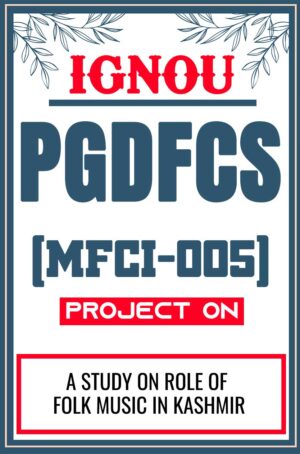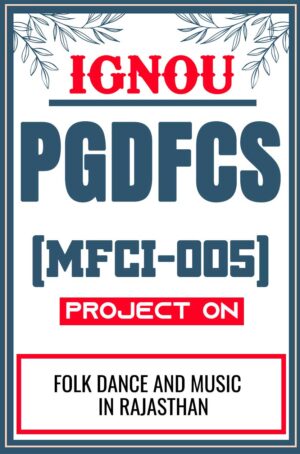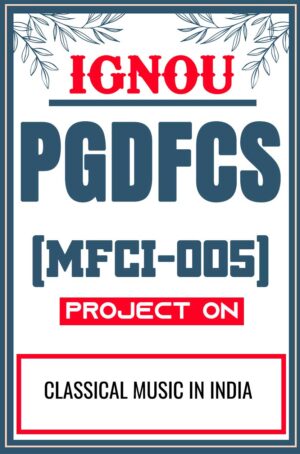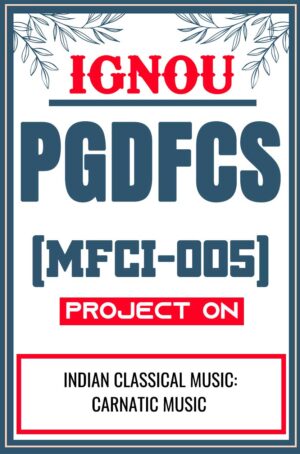Buy IGNOU PGDFCS Project for MFCI 5
The IGNOU PGDFCS Project (Post Graduate Diploma in Folklore and Culture Studies) is a complete practical component that prepares students to do in-depth research and analysis in the fields of folklore, cultural traditions, and heritage studies. MFCI 5, named Project Work, aims to apply theoretical principles taught in the program to real-world cultural occurrences.
The project asks students to identify a folklore aspect, such as oral traditions, myths, songs, dance forms, rituals, or local cultural activities. This hands-on research includes fieldwork, interviews, and documentation to investigate and examine the chosen issue. The project stimulates critical thinking on cultural diversity, preservation, and societal effect.
The report should follow a defined framework that includes an introduction, study objectives, methodology (qualitative/ethnographic techniques), data collection, analysis, and conclusion. It highlights the significance of understanding folklore in modern situations, addressing concerns of cultural identity, globalization, and heritage preservation.
Whatsapp us to get the Personalized (Customized) IGNOU PGDFCS Project Report and Synopsis
Download PDF Link for IGNOU PGDFCS Project (MFCI 5)
How can students select a suitable topic for their PGDFCS project?
Selecting a suitable topic for the IGNOU PGDFCS program involves a thoughtful approach to ensure the topic aligns with the course objectives and students’ interests. Here are steps students can follow:
- Identify Personal Interest: Choose a folklore or cultural theme that genuinely interests you, such as oral traditions, myths, rituals, folk songs, dance forms, crafts, or local legends. Personal interest will keep you motivated throughout the research.
- Focus on Regional or Local Folklore: Selecting a topic based on your local or regional folklore allows easier access to resources, interviews, and data collection. For instance, exploring tribal traditions, festivals, or storytelling practices from your community can be highly impactful.
- Align with IGNOU Guidelines: Ensure that the chosen topic adheres to IGNOU’s PGDFCS project requirements, including relevance to folklore, feasibility of fieldwork, and depth of analysis.
- Research Availability of Sources: Opt for topics with sufficient primary and secondary sources. Topics requiring fieldwork, interviews, or archival research should have accessible resources.
- Narrow the Scope: A focused topic is better than a broad one. For example, instead of “Folk Music in India,” you could study “Folk Music of the Bodo Tribe in Assam.”
- Relevance to Current Issues: Select topics addressing cultural preservation, globalization effects on folklore, or endangered traditions to add significance to your project.
- Consult Your Supervisor: Discuss your ideas with your academic guide or supervisor to finalize a suitable, practical, and well-defined topic.
Sample of IGNOU PGDFCS Project topics for MFCI 5
- INDIAN CLASSICAL MUSIC: CARNATIC MUSIC
- CLASSICAL MUSIC IN INDIA
- FOLK DANCE AND MUSIC IN RAJASTHAN
- A STUDY ON ROLE OF FOLK MUSIC IN KASHMIR
- HANDICRAFTS AND FOLK MUSICAL INSTRUMENTS OF PUNJAB
- MUSIC AND DANCE OF UTTAR PRADESH
What research methodologies can be used in the PGDFCS project?
For the IGNOU PGDFCS program, students can use a variety of research methodologies to study folklore and cultural practices. Here are the key methodologies:
Fieldwork Research
- Fieldwork is central to folklore studies. It involves direct interaction with communities to collect data through observation and participation.
- Students can visit villages, towns, or cultural sites to observe and document folklore elements like rituals, songs, dances, storytelling, or crafts.
Ethnographic Method
- This method focuses on immersive, qualitative research where the researcher observes and interacts with participants over time.
- It helps gather detailed cultural narratives, traditions, and practices through firsthand experience.
Interviews and Oral History
- Conduct structured, semi-structured, or unstructured interviews with local elders, performers, or cultural custodians.
- Oral history techniques document stories, myths, legends, and personal accounts that may not be recorded in written form.
Participant Observation
- The researcher actively participates in cultural practices or festivals to gain a deeper understanding of the folklore being studied.
- It provides insights into social and cultural contexts.
Document Analysis
- Analyze historical records, manuscripts, photographs, folklore texts, or community archives related to the chosen topic.
- Secondary data sources can complement fieldwork findings.
Narrative Analysis
- Analyze stories, folk tales, and oral traditions to identify themes, cultural values, and symbolism within the narratives.
Visual Documentation
- Use photographs, audio, and video recordings to document performances, crafts, or rituals. This method enhances the authenticity of the project.
Case Study Approach
- Focus on a specific community, tradition, or folklore element as a case study to explore its significance in depth.
How important is fieldwork for the IGNOU PGDFCS Project?
Fieldwork is extremely important for the IGNOU PGDFCS Project, as it forms the backbone of folklore and cultural studies research. Here’s why fieldwork is essential:
Direct Engagement with Folklore:
Fieldwork allows students to interact with communities, observe cultural practices, and document living traditions firsthand. This direct engagement ensures an authentic understanding of folklore elements like oral narratives, rituals, festivals, dance, music, and crafts.
Primary Data Collection:
Folklore often exists in oral and non-documented forms, making fieldwork crucial for collecting primary data through interviews, observations, and participation.
Preservation of Intangible Cultural Heritage:
By documenting folklore through fieldwork, students contribute to preserving endangered traditions, cultural expressions, and knowledge that may otherwise be lost over time.
Contextual Understanding:
Fieldwork provides deeper insights into the cultural, social, and regional contexts of folklore, which cannot be fully understood through secondary sources alone.
Building Research Skills:
Conducting fieldwork develops essential research skills such as interviewing, ethnographic observation, documentation, and analysis. It prepares students for further academic or professional endeavors in cultural studies.
Authenticity and Credibility:
A project rooted in fieldwork enhances the credibility of the research findings. It demonstrates the student’s commitment to exploring folklore in its natural setting.
Bridging Theory and Practice:
Fieldwork allows students to apply theoretical concepts learned in the PGDFCS program to real-world scenarios, bridging the gap between classroom knowledge and practical application.
What types of folklore elements can be explored in the PGDFCS project?
In the MFCI 5 project of the IGNOU PGDFCS program, students can explore a variety of folklore elements that represent the rich cultural heritage of communities. The following types of folklore elements can be studied:
Oral Traditions
- Stories, myths, legends, fables, epics, and proverbs passed down through generations.
- Example: Folk tales like Panchatantra stories or tribal myths explaining the origin of the universe.
Folk Songs and Music
- Traditional songs, lullabies, work songs, wedding songs, and ritualistic music.
- Example: Bihu songs in Assam, Bhajans in Gujarat, or tribal drumming traditions.
Folk Dances and Performances
- Traditional dance forms or dramatic performances linked to rituals, festivals, or storytelling.
- Example: Garba of Gujarat, Chhau dance of Odisha, or Yakshagana from Karnataka.
Rituals and Festivals
- Cultural practices tied to religion, community celebrations, or life events.
- Example: Harvest festivals like Pongal, rituals during marriage, or tribal initiation ceremonies.
Folk Art and Crafts
- Handicrafts, paintings, embroidery, pottery, and other traditional creative expressions.
- Example: Madhubani paintings, Warli art, or handmade terracotta artifacts.
Oral Histories and Narratives
- Stories or personal accounts shared by elders that preserve cultural memory and community identity.
- Example: Memories of migration, historical folklore, or community struggles.
Superstitions and Beliefs
- Folk beliefs, omens, or practices rooted in traditional wisdom or community faith.
- Example: Beliefs about eclipses, spirits, or medicinal folklore.
Folk Games and Sports
- Traditional games and recreational activities unique to specific cultures.
- Example: Kabaddi, Gilli-Danda, or regional board games.
Customs and Traditions
- Practices associated with birth, marriage, death, or seasonal events.
- Example: Naming ceremonies, harvest traditions, or ancestral worship rituals.
Food and Culinary Traditions
- Traditional recipes, food preparation techniques, and cultural symbolism of specific cuisines.
- Example: Festive foods like Pongal rice, traditional tribal dishes, or fermented foods.
Folk Medicine and Healing Practices
- Indigenous knowledge of herbal medicine, healing rituals, and community health practices.
- Example: Ayurveda remedies or tribal shamanic healing.
Symbols, Charms, and Totems
- Use of symbols, amulets, or totems for protection, good fortune, or rituals.
- Example: Totem poles or sacred charms.
Folk Architecture
- Traditional housing styles, temples, or communal structures with cultural significance.
- Example: Bamboo houses of Northeast India or terracotta temples in Bengal.
How does the IGNOU PGDFCS Project contribute to understanding folklore and culture?
The IGNOU PGDFCS Project plays a crucial role in enhancing the understanding of folklore and culture through both theoretical and practical exploration. Here’s how it contributes:
Documentation and Preservation of Folklore
The project encourages students to document and analyze folklore traditions such as myths, oral narratives, rituals, music, and dances. By studying these elements, students help preserve intangible cultural heritage that might otherwise fade due to modernization or lack of recording.
Deep Cultural Insight
Through fieldwork and immersive research, students gain a comprehensive understanding of the social, historical, and cultural contexts in which folklore is created and transmitted. It sheds light on how traditions reflect community values, beliefs, and identities.
Bridging Tradition and Modernity
The project explores how folklore adapts to changing times, addressing themes like globalization, digital influence, and cultural integration. This allows students to analyze folklore’s role in maintaining cultural continuity amidst modern influences.
Fieldwork Experience
The hands-on nature of the MFCI 5 project, such as interviews, participant observation, and case studies, offers a real-world understanding of folklore. Students witness cultural practices firsthand, enriching their knowledge beyond textbooks.
Highlighting Regional Diversity
India is a land of diverse traditions and folklore. By exploring specific regional or community-based cultural practices, the project highlights the rich diversity of India’s heritage.
Interpreting Symbols and Meanings
Students learn to decode the symbolic meanings embedded in folklore, such as oral stories, festivals, and art forms, which often reflect deeper cultural and spiritual significance.
Promoting Cultural Awareness
The project fosters appreciation and respect for cultural diversity, enabling students to understand how folklore shapes collective identities and strengthens social bonds within communities.
Academic and Practical Contribution
The MFCI 5 project allows students to contribute to the academic field of folklore studies. Their findings may be used as references for future research or initiatives aimed at cultural preservation.
What is the ideal length and structure of the IGNOU PGDFCS Project?
The IGNOU PGDFCS Project has a specific format and structure to ensure clarity, consistency, and academic rigor. The ideal length of the project is typically 8,000 to 10,000 words (approximately 60–80 pages), though this may vary based on IGNOU guidelines. Here’s the suggested structure:
1. Title Page
- Title of the project
- Student’s name and enrollment number
- Course code: MFCI 5
- Program name: PGDFCS
- Regional Centre and Study Centre details
- Supervisor’s name
- Submission date
2. Declaration and Certificate
- A declaration by the student affirming the originality of the work.
- A certificate of approval signed by the project supervisor.
3. Acknowledgements
- A brief section thanking individuals or institutions that supported the project.
4. Table of Contents
- A list of chapters and sub-sections with corresponding page numbers.
5. Introduction
- Define the topic and provide the rationale for selecting it.
- State the research objectives and scope of the project.
- Highlight the significance of the study in understanding folklore and culture.
6. Review of Literature
- Summarize previous studies, books, and research papers related to your topic.
- Identify research gaps that your project aims to address.
7. Research Methodology
- Research Design: Explain the overall approach (qualitative, ethnographic, or descriptive).
- Data Collection Methods: Describe tools like fieldwork, interviews, participant observation, or document analysis.
- Study Area: Mention the geographical or cultural community being studied.
- Sampling: State how informants or participants were selected.
- Tools: Discuss recording methods (audio, video, photography, or written documentation).
8. Data Analysis and Findings
- Present the collected data in an organized manner (thematically or narratively).
- Include transcripts, folklore texts, rituals, or interviews.
- Use visuals like photographs, charts, or tables for clarity.
9. Interpretation and Discussion
- Analyze and interpret the findings, linking them to cultural, historical, or social contexts.
- Discuss the significance of the folklore elements studied and how they reflect community values, beliefs, or traditions.
10. Conclusion and Suggestions
- Summarize the key findings of the study.
- Highlight the importance of preserving the folklore studied.
- Provide suggestions for further research.
11. References/Bibliography
- List all sources used in the project (books, journals, websites, interviews) following a proper citation style (APA, MLA, etc.).
12. Appendices (if any)
- Include additional materials like interview transcripts, maps, questionnaires, or photographs.
Ideal Length per Section:
- Introduction: 5–8 pages
- Review of Literature: 10–12 pages
- Research Methodology: 8–10 pages
- Data Analysis and Findings: 20–25 pages
- Interpretation and Discussion: 10–12 pages
- Conclusion: 5–8 pages
Ready to get your IGNOU PGDFCS Project Report and Synopsis Sample PDF for MFCI 5?
- Call us or WhatsApp us at: 9958947060, 9354637830
- Visit: SHRICHAKRADHAR.COM
-
Sale!

-
Sale!

IGNOU PGDFCS Project (MFCI-005) Synopsis/Proposal & Project Report/Dissertation in Hard-Copy (Sample-5)
Original price was: ₹499.00.₹249.00Current price is: ₹249.00. -
Sale!

IGNOU PGDFCS Project (MFCI-005) Synopsis/Proposal & Project Report/Dissertation in Hard-Copy (Sample-4)
Original price was: ₹499.00.₹249.00Current price is: ₹249.00. -
Sale!

IGNOU PGDFCS Project (MFCI-005) Synopsis/Proposal & Project Report/Dissertation in Hard-Copy (Sample-3)
Original price was: ₹499.00.₹249.00Current price is: ₹249.00. -
Sale!

IGNOU PGDFCS Project (MFCI-005) Synopsis/Proposal & Project Report/Dissertation in Hard-Copy (Sample-2)
Original price was: ₹499.00.₹249.00Current price is: ₹249.00. -
Sale!

IGNOU PGDFCS Project (MFCI-005) Synopsis/Proposal & Project Report/Dissertation in Hard-Copy (Sample-1)
Original price was: ₹499.00.₹249.00Current price is: ₹249.00.
